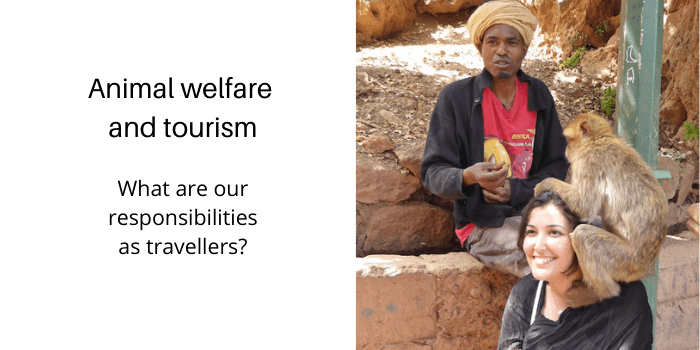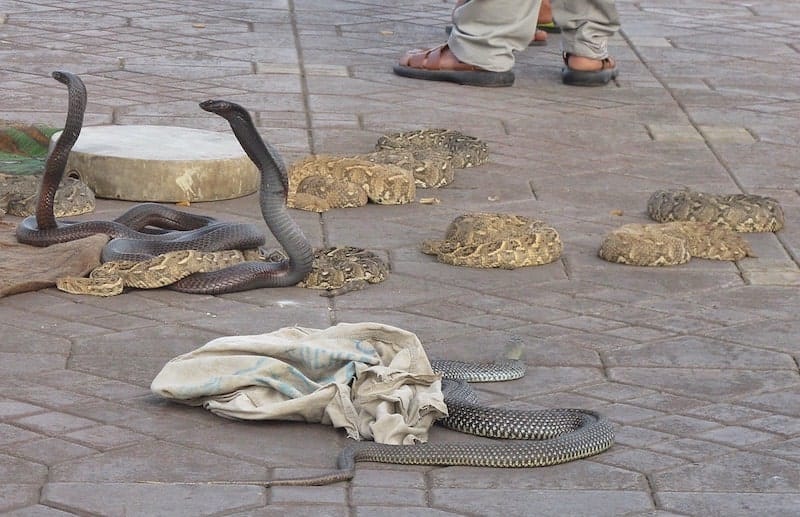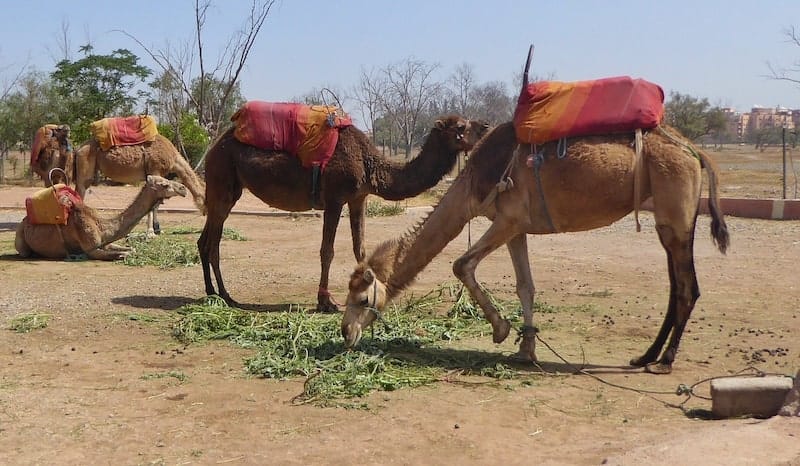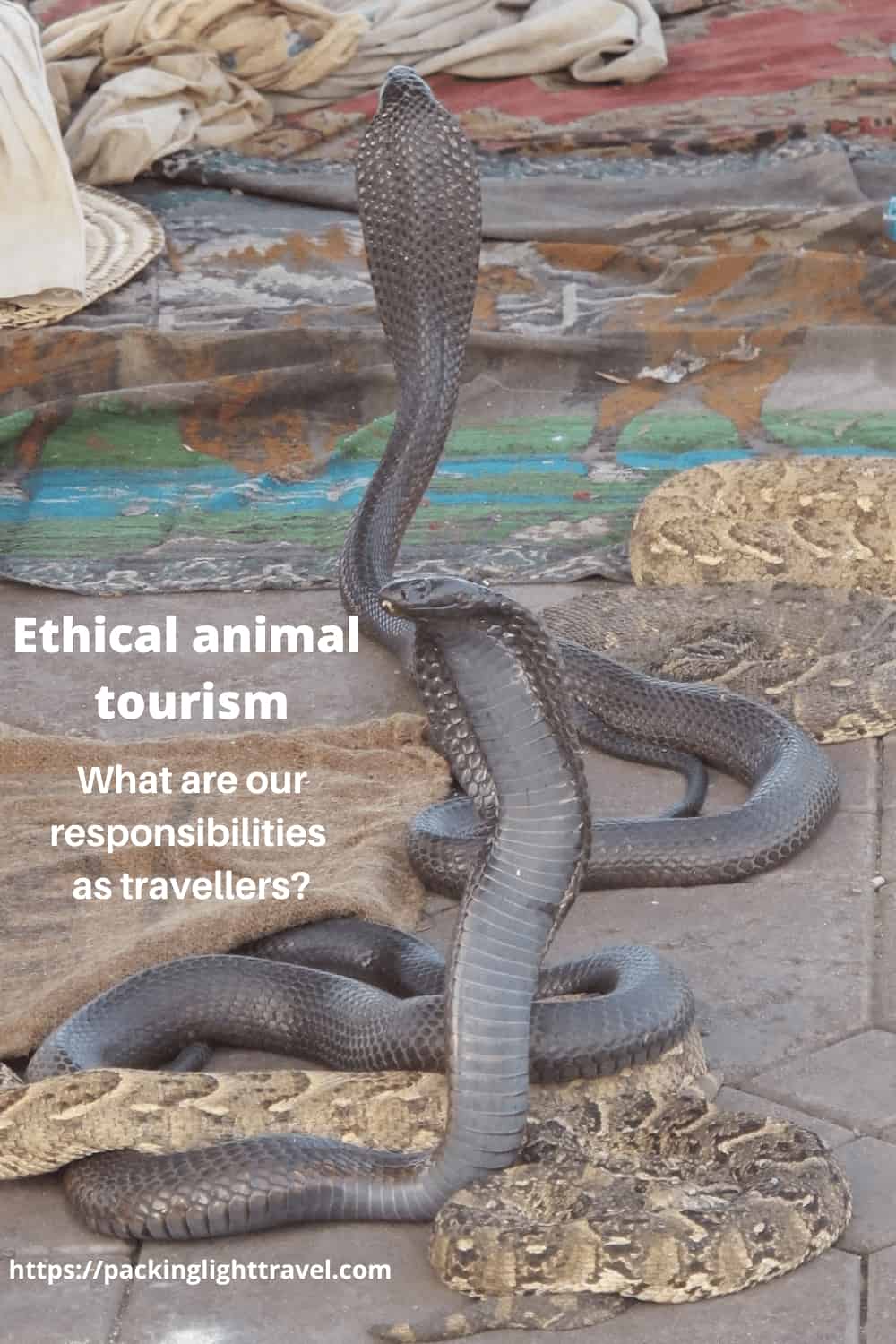Updated January 14, 2025
How do you practise ethical animal tourism? Occasionally in my travels, I’m forced to confront my attitudes towards animal welfare and its relationship to tourism. Before a trip to Morocco, it had been relatively easy. I steered clear of zoos and avoided riding or handling any animal I perceived to be exploited for the benefit of tourists. In Morocco, the animals I encountered encouraged me to think more about ethical animal tourism and our responsibilities as travellers.
Animal tourism in Marrakech
Marrakech challenged my thinking. The early decisions were easy, such as not hiring one of the calèches lined up on the outskirts of Jamaâ El Fna Square. Hitched to each calèche were two horses standing on pavement in 42-degree (Celsius) heat. Each was competing for the tiny patch of shade provided by the carriage in front.
Or avoiding the macaque monkeys with a chain around their necks, wearing dirty diapers to protect tourists as they clambered over people’s heads and shoulders. The camels tethered to concrete blocks on short ropes waiting in the hot sun for tourists seemed totally out of their element, so bypassing them also wasn’t difficult.
However, the snake charmers and their snakes were another story. This was the first time coming across the practice so I was curious, to say the least. The thing about Marrakech compared to most other places is that simply taking a photograph will cost you a financial contribution. Looking was free. My hostel roommate from Germany was caught surreptitiously snapping a picture.
Her required donation gave her access to more photographs.
I must admit, I couldn’t bear to look at the monkeys shackled at the neck, and gave them a wide berth. I had the same reaction to the horses standing in the oppressive heat. They were plagued by scores of flies buzzing about their heads. It was saddening. The camels? They appeared to be well fed but I walked past them with a furtive glance and covert photograph.
But those snake charmers. There was something about them and their snakes that brought me back to Jamaâ El Fna Square time and time again. On a conscious level, I knew the hot pavement of the square wasn’t a suitable habitat for any species in the animal kingdom. But perhaps on another level, I placed snakes on a different rung on the hierarchy. My discomfort wasn’t as intense as what I felt for the horses, camels, and monkeys. However, I figured if I didn’t take any photographs, I wasn’t supporting the fact that as wild animals, they didn’t belong there, performing for tourists. Hypocritical? Yes. I was supporting their treatment by being a curious and engaged bystander.
Ethical animal tourism and our responsibilities as travellers
My discomfort at seeing the variety of ways people use animals to eke out a living in Marrakech challenged me to think more about animal welfare and tourism. It prompted questions for which I didn’t have answers.
- What’s appropriate?
- If a practice is rooted in tradition, is it acceptable for tourists to condemn it based on their own cultural values?
- If an animal appears to be healthy and treated well, should the operator be supported?
- If we suspect an animal’s welfare is at risk, what are our responsibilities as travellers?
- What are the key criteria for assessing animal-friendly tourism?
- How should we use our tourist dollars to support ethical and sustainable animal tourism?
These four simple approaches are helpful:
1. Assessment steps and tips
For answers, I looked to Leyla Giray Alyanak who blogs at Women on the Road. Leyla writes compelling, thought-provoking articles on social issues for travellers. Her article, 8 Steps to Animal-Friendly Tourism: Making Travel Cruelty-Free was just what I was looking for. It included a list of questions to assess whether or not an activity is animal-friendly.
Lonely Planet’s How to be a responsible wildlife tourist was just as helpful. It helped answer my question about whether or not it was acceptable to support an operator with animals that appeared to be healthy and well fed. The article offered a few other questions to ask: “Do they have room to move and display natural behaviours? Is there protection from the weather and somewhere for them to go to be away from visitors?” Unfortunately, none of the animals I observed in Marrakech met those tests.
2. Pros and cons of visiting a zoo
On the question of zoos, I looked to the Tourism Teacher. Dr Hayley Stanton’s Are zoo’s ethical? The pros and cons of visiting the zoo discourages blanket boycotting of zoos. She urges readers to evaluate what a particular facility is doing in terms of education, research, breeding, and conservation. Another consideration is whether or not the country in question has a regulatory framework governing animal welfare in zoos.
3. Is it a sustainable alternative?
Is washing an elephant an acceptable alternative to riding one? Bathing elephants at animal sanctuaries is a popular activity for tourists in Thailand. However, according to the international non-profit organization, World Animal Protection, the population of captive elephants has increased 134% between 2010 and 2020, with estimates that around 2,800 elephants are being held across Thailand in tourism venues.
“Elephants are highly intelligent animals with the capacity for complex thoughts and emotions,” the charity said in a 2020 report. “Managing elephants is extremely high risk and highlights their unsuitability for captive environments, especially when in direct contact with people.” This view translated into unfortunate and avoidable results when a tourist was gored to death while bathing an elephant in Thailand in early 2025.
4. Follow 5 simple guidelines
And finally, I appreciated 5 Guidelines for Ethical Wildlife Tourism by wildlife biologist, Dr Stephanie Schuttler. The author helps travellers navigate and assess grey areas such as rescue and rehabilitation centres and animal sanctuaries. She offers suggestions on how to recognize ethical wildlife tourism, and evaluate explanations on why some animals are housed in rescue situations. A link is provided to a list of accredited zoos and aquariums.
Now it’s over to you. Please add your thoughts or links to other resources in the comments. Also, if you found this post helpful, please share it by selecting one or more social media buttons.
Care to pin it for later?











Unfortunately Maroco is not the best country in the world when talking animal welfare. I would definitely prefer a bike over calèche but traditions are traditions you know. Good luck with the blog.
CyclistPro recently posted…How To Choose The Best Cycling Computer
Yeah..it definitely challenges you when you see those poor animals. My husband is a big softie when it comes to animals. In his nirvana , he would be rich, with a humongous compound filled with animals that roam free. We chose not to ride the animals or give the outrageous amount they wanted for pictures. I think l would ride a camel maybe..but l think animals should be free of those shackles. On the other hand, it’s usually the only source of income for these people. Tough one. Great post!
Very good post. I’ve had horses all my life and that photo of the two in your post is breaking my heart – their tack is really poor, badly fitting and must be rubbing – not to mention the heat they’re stood in and the fact one is hobbled 🙁 horrific.
I avoid any animal-based things when travelling unless I know they keep their animals to the same standards I would – which requires a lot of research and generally rules out most things. It never sits right with me to support anything suffering.
Caroline @ PACKTHESUITCASES recently posted…20 things to do in North Berwick, Scotland: the perfect seaside town
Thank you for sharing your personal experience and reflections on ethical animal tourism in Morocco. It is important for all of us to consider our responsibilities as travellers and be mindful of the impact our actions have on animals.
I appreciate the resources you provided, especially the Women on the Road and Tourism Teacher articles, which offer practical steps and questions to evaluate whether an activity or operator is animal-friendly. It’s encouraging to see more information and awareness around ethical tourism, and I hope more travellers will take the time to educate themselves before engaging in animal-related activities.
It’s important to remember that cultural values and traditions may not always align with our own beliefs on animal welfare, but that doesn’t mean we should turn a blind eye to animal suffering. As responsible travellers, we should strive to support ethical and sustainable animal tourism and encourage operators to prioritize animal welfare.
Thank you again for bringing attention to this important issue and providing helpful resources for those of us who want to make a positive impact through our travels.
Aca Baranton recently posted…How to remove tick from dog with alcohol
Such an important read on animal welfare in tourism! Your insights and tips are a valuable guide for conscious travelers. Let’s make sure our adventures leave a positive pawprint on the world. Thanks for shedding light on this crucial topic!
Great points on ethical animal tourism! It’s important to consider the well-being of animals while traveling. Avoiding exploitative activities and supporting conservation efforts are key practices for responsible tourism.